Introduction
When you walk into a modern musée, you will find that it is no longer just a simple combination of “cultural relics + information signs.” The screen moves, and the sound and information are available at a touch.
These immersive visiting experiences are the magical changes brought by LED display screens.
From interactive games to story interpretation, from spatial atmosphere to cultural heritage, Écrans d'affichage LED are quietly changing the appearance of museums. So, how does it make cultural relics “come alive” and make culture more moving?
Table des matières
1. Advantages of LED display screens in museums
1). Visual effects and display flexibility
LED display screens are very powerful and can show the details of cultural relics clearly; just like putting cultural relics under a magnifying glass, even the smallest details can be seen clearly.
Moreover, no matter whether the light in the exhibition hall is bright or dark, the content on the screen can be seen clearly without worrying about not being able to see clearly.
The best thing is that the size and shape of this screen can be customized, and the museum can put it however it wants.
For example, if there is a large space in the exhibition hall, you can put a super large screen, which is particularly spectacular; if the space is smaller, you can also put a small screen, which does not waste space at all.
Moreover, the shape of the screen can also be very special. It does not have to be square. It can be round, curved, or even strange.
It can perfectly match the architectural style or exhibition theme of the museum, making the entire exhibition hall look more interesting.
2). Improved interactive experience
Many LED screens in museums now have touch functions. Visitors can click on them and click on whatever they want to know.
For example, if you see an antique and are curious about how it was made, just click it lightly, and a video of the production process will appear on the screen.
If you want to see the details of the antique, you can also enlarge the picture, just like holding a magnifying glass.
Moreover, these screens can also sense the audience’s movements. For example, when the audience approaches the screen, the screen will automatically play the relevant introduction video or respond according to the audience’s movements.
For example, when the audience waves, the things on the screen will move, which is very fun.
This interactive method allows the audience to no longer watch the exhibition dryly but to truly participate in it, feeling like they are exploring the secrets of cultural relics.
3). Richness of information dissemination
LED display screens are very powerful and can display everything. It can display text, pictures, videos, and audio, and the content is very rich.
For example, when displaying an ancient cultural relic, the screen can simultaneously display high-definition pictures of the cultural relic, videos of the production process, and audio of expert explanations so that the audience can understand the cultural relic from different angles.
Moreover, this screen can also support multiple languages, which is very convenient for foreign tourists.
For example, if there is an international exhibition in the museum, the screen can introduce the cultural relics in Chinese, English, Japanese, and other languages at the same time so that audiences from different countries can understand them.
In this way, the museum can attract more foreign tourists and promote exchanges between different cultures so that everyone can better understand each other’s culture.
2. Application strategy of LED display screens in different areas of the museum
1). Hall and entrance area
In the hall and entrance of the museum, people come and go, and at this time, a large LED display screen is needed to attract everyone’s attention.
This screen can be used to display the introduction of the museum so that the audience can quickly understand the history and characteristics of the museum.
It can also scroll the exhibition information to tell everyone which exhibitions are worth seeing now, if there are upcoming events, they can also be announced in advance to facilitate the audience to arrange a visit plan.
Moreover, in order to let the audience feel the charm of the museum as soon as they enter the door, some dynamic welcome pictures can be designed.
For example, use animation to show the museum’s iconic cultural relics or use video to introduce the museum’s architectural features, so that the audience can immerse themselves in it and be brightened as soon as they enter the door.
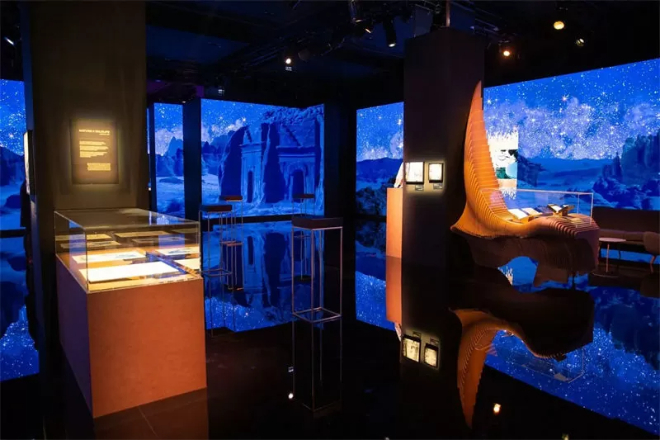
2). Cultural Relics Display Area
Put some small LED screens next to the cultural relics display cabinets, which is like giving each cultural relic a “narrator.”
These screens can introduce the background of the cultural relics in detail, such as where it was unearthed and what the social environment was like at the time.
They can also tell the history of the cultural relics, what eras it has experienced, and what stories are behind it.
If the production process of the cultural relics is very complicated, the screen can also show it in detail, so that the audience can understand why this cultural relic is so precious.
What’s even more amazing is that by using 3D modeling and animation technology, the restoration process of cultural relics can be shown on the screen, and the audience can see how experts repair damaged cultural relics bit by bit, or reproduce the use scenes of cultural relics.
For example, the use scenes of ancient tableware in ancient banquets can be shown on the screen, giving the audience a stronger sense of involvement.
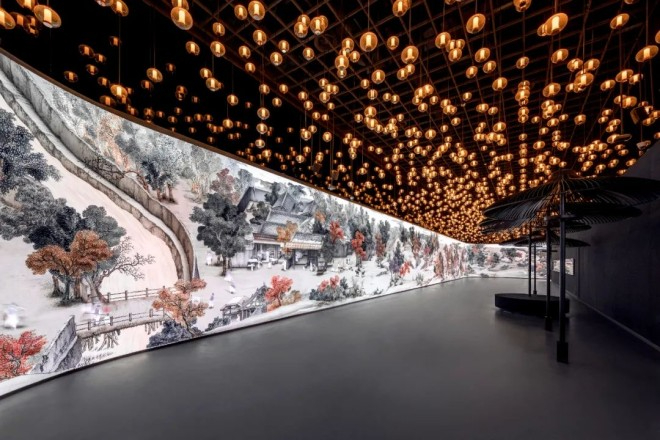
3). Temporary Exhibition Area
The exhibition content of the temporary exhibition area changes frequently, so the content of the LED display screen should also be customized accordingly. The screen can display specially designed content according to different exhibition themes.
For example, if the theme of the exhibition is ancient art, the screen can show the creative process of ancient artists.
If the theme is modern technology, it can show some cutting-edge scientific and technological achievements. This will not only enhance the attraction of the exhibition but also allow the audience to learn more knowledge.
In addition, the screen in the temporary exhibition area can also play multimedia materials related to the exhibition, such as documentaries, interview videos, etc.
For example, if the theme of the exhibition is the work of a famous painter, you can play a documentary about the painter’s life or interview videos of his family and friends so that the audience can understand the exhibition content from different angles.
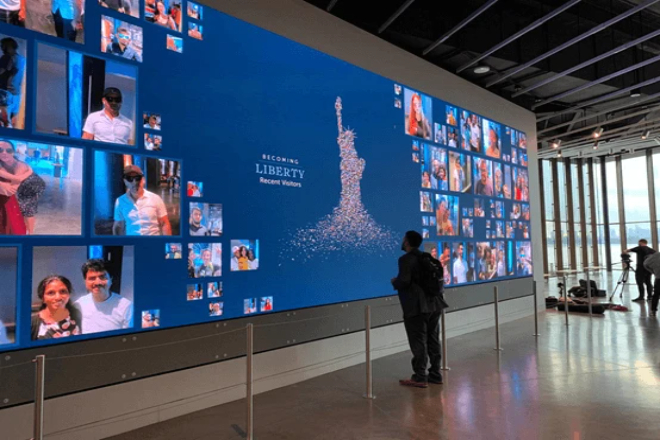
4). Educational activity area
In the educational activity area, the LED display is a super easy-to-use teaching aid.
If there are teaching activities, the screen can display teaching courseware, such as explaining the structure of ancient buildings, and various architectural drawings and models can be clearly displayed on the screen.
It can also display interactive games so that children can learn knowledge while playing games.
In addition, the screens in this area can also be used for distance education activities. Through network connection, the museum can cooperate with other educational institutions.
For example, by connecting with schools, students in the school can also visit the museum remotely and listen to the explanations of museum experts, so that the museum’s educational resources can be shared with more people.
3. How museums tell stories about cultural relics through LED screens
1). Make the story interesting
If you want to make the story of cultural relics attractive, you have to make a good story first. Museum staff can write down the origins of cultural relics and the little stories behind them, just like writing a script.
For example, tell how an antique was dug out from the ground, who its previous owner was, and what happened to it. Then, add some sound and video, such as ancient music and videos of archaeological sites, to make the story sound more touching.
Now, many LED screens can be used together with several screens, just like setting up a big organiser.
For example, one screen shows pictures of cultural relics, another plays videos, and another writes text descriptions so that the story can be told more smoothly and more interestingly, and the audience can also follow the story step by step to understand the cultural relics in depth.
2). Tell stories with various tricks
Telling stories about cultural relics cannot rely on words alone but must use various tricks.
For example, to display ancient porcelain, first put a high-definition picture on the screen so that the audience can see its pattern and color clearly.
Then play a video to show how the porcelain is made; then add some ancient music as background music, and finally use text to add some details, such as when the porcelain was made and what it is used for.
You can also use animation and special effects to attract the audience. For example, animation can be used to show how cultural relics were used in ancient times or to make patterns on cultural relics “move.”
This will not only catch the audience’s attention but also allow them to feel the charm of cultural relics more deeply.
3). Let the audience participate
Stories cannot be told by the museum alone, but the audience must also participate. You can design some interactive links on the LED screen, such as asking the audience questions or letting them choose the direction of the story by touching the screen.
In this way, the audience is no longer a dry listener but a part of the story, and they will be more interested in understanding the cultural relics.
In addition, you can also use the sharing function of social media to encourage the audience to share their feelings about listening to the story or their views on the cultural relics.
For example, the audience can generate a picture with a picture of the cultural relic and their own feelings on the screen and then share it with Moments or Weibo with one click.
This will not only allow more people to understand the stories of cultural relics but also make the museum more influential.
4. Methods of creating a cultural atmosphere in museums with LED display screens
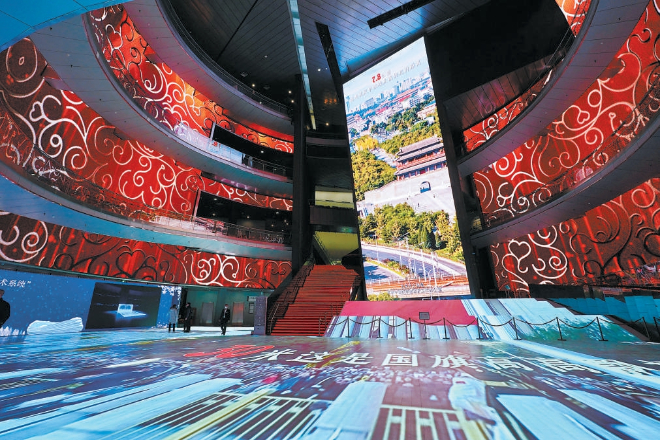
1). Space atmosphere design
The space design of the museum is very important, and the LED display screen cannot be placed casually.
The appearance and layout of the screen must be designed according to the architectural style and cultural theme of the museum.
For example, if the architectural style of the museum is antique, the frame of the LED screen can be designed in a simple wooden style and placed in the corner or wall of the exhibition hall to blend in with the surrounding environment.
If the theme of the exhibition is more modern, the screen can be designed with simple lines and shapes and placed in the center of the exhibition hall, which is particularly eye-catching. Lighting is also critical.
By adjusting the color and brightness of the screen and matching the lighting of the exhibition hall, an atmosphere that matches the theme of the exhibition can be created.
For example, when displaying ancient cultural relics, the screen can use warm tones and dim the lights a little, giving people a solemn and mysterious feeling; when displaying modern art, the screen can use bright colors and brighter lights to appear lively and fashionable.
2). Integration of cultural elements
In the content of the LED display screen, more local traditional cultural symbols and artistic elements can be added.
For example, if the museum is in a Jiangnan water town, the screen can display some water town scenery, traditional embroidery patterns, or paper-cutting art.
In this way, the audience can feel the local cultural characteristics when watching the screen. The screen can also be used to display artworks and designs related to the museum’s culture.
For example, the museum has a collection of many ancient calligraphy and paintings.
The screen can display some works of calligraphers and painters or design some animations based on calligraphy and painting works so that the audience can feel the charm of traditional culture more intuitively.
In this way, the screen is not only a tool for displaying information but also a carrier of cultural communication.
3). Combination of sound and vision
It is not enough to have a picture and the sound is also very important. According to the picture content of the LED display, you can design appropriate background music and sound effects.
For example, when showing ancient war scenes, accompanied by the sound of war horses neighing and swords colliding, the audience can feel more involved.
When showing natural scenery, accompanied by the sound of birds singing and flowing water, the audience feels like they are in the scene. Sound can also guide the audience’s attention and emotional experience.
For example, when the screen plays an important historical event accompanied by exciting music, the audience’s emotions will be mobilized.
When playing some quiet pictures accompanied by soft music, the audience can relax and better appreciate the content.
Through the combination of sound and vision, the cultural atmosphere of the museum can be more vivid and three-dimensional.
5. Interactive experience design of LED display screens in museums
1). Interactive game development
The LED screens in the museum can be used to design some fun games. These games are related to cultural relics knowledge and allow the audience to learn something while playing.
For example, you can design a jigsaw puzzle game, shuffle the pictures of cultural relics, and let the audience put them together by touching the screen. After the puzzle is completed, a detailed introduction of the cultural relics will pop up on the screen.
The audience can not only have fun but also learn knowledge. There is also a treasure hunt game, where the audience can find clues in the exhibition hall, unlock the next level by touching the screen, and finally find the “treasure,” which can be a detailed story of the cultural relics or a small gift.
In this way, the audience can learn while playing in the museum, which is particularly interesting.
2). Audience feedback and interaction
The museum can design an audience feedback system to allow the audience to express their opinions on the exhibition content.
For example, an LED screen can be placed in a corner of the exhibition hall, and the audience can leave messages directly on the screen to talk about their feelings about the exhibition or make some suggestions.
These messages can be displayed on the screen in real-time so that other viewers can also see them.
You can also design a photo wall where the audience can take photos in the exhibition hall and then upload the photos to the photo wall on the screen through the WeChat applet or the on-site equipment.
In this way, the audience can see their own and other people’s photos and have a sense of participation.
The museum can also adjust the exhibition content in time according to the feedback of the audience to make the exhibition more popular.
3). Social interaction function
Nowadays, everyone likes to share their experiences on social media. The museum can use this to allow the audience to share their experiences conveniently after the visit.
For example, set a share button on the LED screen, and the audience can directly share the photos of the exhibition or their own feelings to their circle of friends, Weibo, and other platforms after clicking.
You can also design some online interactive activities, such as voting. The audience can vote for their favorite cultural relics on the screen and finally select the “most popular cultural relics” based on the voting results.
Or hold a lottery event, and the audience can draw on the screen after the visit and have the opportunity to win souvenirs from the museum.
In this way, the audience can not only participate in offline interactions but also share their visiting experiences with more people online, increasing the influence of the museum.
6. Analysis of Famous Museum LED Display Case Studies
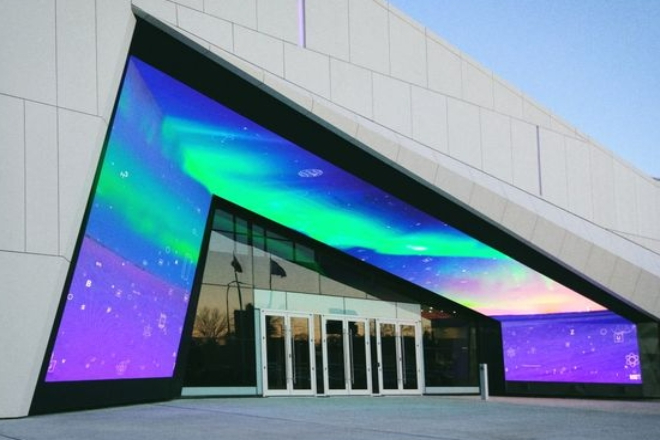
1). Canadian Museum of Science and Technology
The Canadian Museum of Science and Technology is located in Ottawa, which is a very interesting place.
The entrance of the museum is surrounded by a circle of LED displays. These screens look very cool and can play a variety of colorful videos, which is very attractive. Ewe dot pitch ren ekkei LED mi pwarata non nenien urumot ina P6.
The shape and size are specially customized to perfectly match the roof line of the museum, and it looks like a huge LED ceiling.
This design not only makes the museum look more technological but also very modern and memorable.
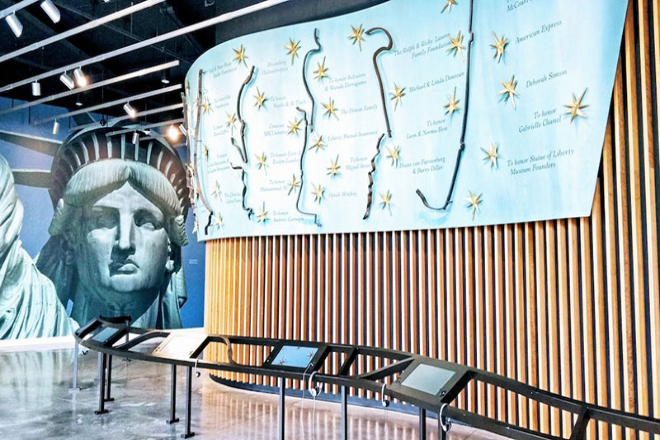
2). Statue of Liberty Museum in New York
The Statue of Liberty Museum in New York also did some very interesting things with LED displays.
The museum tour starts with an immersive theater. As soon as you enter, you can see a documentary that takes visitors “flying” around the Statue of Liberty and tells the story of the Statue of Liberty from beginning to end.
There is also an inspiration gallery where visitors can add their own self-portraits and inspirational sentences to a digital mural and feel that they have become part of the story of the Statue of Liberty.
This interactive LED display not only makes visitors more involved but also has special educational significance.
3). In museums with different cultural themes, how to design the content and form of LED screens according to the characteristics of the theme
In museums with different cultural themes, the content and form of LED screens should be designed according to the theme of the museum.
For example, in science and technology museums, LED screens usually display some cool scientific and technological achievements and interactive experiences, which make the audience feel particularly fun.
In historical and cultural museums, LED screens will be used more to reproduce historical scenes, tell the stories behind cultural relics, and make the audience feel more involved.
In art museums, LED screens may be used to show the creation process of artworks, allowing the audience to feel the charm of art more intuitively.
7. Conclusion
LED display screens are not just display tools, but also a “new context” for museums to tell stories and pass on culture.
Through flexible application and creative design, it allows museums to retain the historical weight while being full of modern interactive vitality.
In the future, the combination of museums and technology will be closer and more exciting.
Enfin, si vous souhaitez en savoir plus sur les écrans d'affichage LED, veuillez nous contacter.
